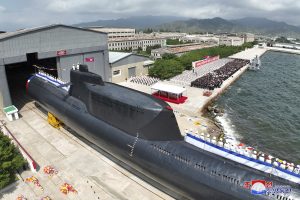On August 27, North Korea registered 13 submarines with the International Maritime Organization (IMO) – the first time it had ever done so. A day later, it withdrew all the registrations.
North Korea’s brief registration and subsequent withdrawal of 13 submarines from the IMO registry have generated significant international concern and debate. This fleeting yet intriguing episode sheds light on Pyongyang’s strategic maneuvers and the broader implications for regional security and international maritime norms.
When North Korea took the unprecedented step of registering 13 submarines with the IMO, it listed three types of submarines: 11 Sang-O Il-class submarines, one Sinpo-class sub (the 8.24 Yongung), and – most notably – the Sinpo-C-class Hero Kim Kun Ok, which is reportedly capable of carrying nuclear missiles.
This move was surprising given North Korea’s history of secrecy surrounding its military capabilities, particularly those related to its nuclear program. The registration was interpreted by some as a potential shift toward greater transparency, albeit a puzzling one considering Pyongyang’s usual approach to its military assets.
However, just a day later, these submarines were abruptly removed from the IMO’s Global Integrated Shipping Information System (GISIS). This sudden withdrawal led to widespread speculation about North Korea’s intentions. Some analysts suggested that the registration might have been an error or a strategic move designed to provoke a response from the international community. The rapid reversal could indicate that North Korea had achieved its objective – whether that was to test international reactions, gather intelligence, or assert its presence on the global stage.
North Korea’s actions may also reflect a broader strategy of signaling its naval advancements without fully committing to transparency. By briefly registering its submarines, Pyongyang may have sought to demonstrate its growing military capabilities, particularly in the realm of submarine-launched ballistic missiles (SLBMs). The subsequent withdrawal from the registry, however, suggests a desire to maintain strategic ambiguity, keeping the international community guessing about its true intentions.
The implications of this incident for regional security are significant. North Korea’s submarine fleet, especially those capable of launching SLBMs, is a critical component of its nuclear deterrent. The Hero Kim Gun Ok, which was among the submarines registered, represents a major upgrade in North Korea’s naval capabilities, potentially altering the strategic balance in East Asia. This development poses a direct challenge to the security of countries like South Korea and Japan, which are within striking range of these submarines.
Moreover, the registration of these submarines could have been a precursor to more assertive naval operations by North Korea, such as increased patrols in international waters or even port visits in friendly nations. This would mark a significant shift in North Korea’s naval strategy from a traditionally defensive posture focused on coastal defense to a more assertive, potentially offensive role in the region.
However, the rapid withdrawal from the IMO registry leaves open the question of whether North Korea intends to proceed with such actions or if this was merely a tactical feint. The ambiguity surrounding Pyongyang’s intentions exacerbates the already high levels of tension in the region and complicates efforts by neighboring countries and the broader international community to assess and respond to potential threats.
This incident also raises important questions about the integrity of international maritime norms and the role of the IMO in enforcing these standards. The IMO is crucial for ensuring maritime safety, security, and environmental protection through the regulation of shipping activities. Typically, military vessels, especially those capable of carrying nuclear weapons, are not registered with the IMO, making North Korea’s initial decision highly unusual.
By briefly complying with IMO regulations, North Korea may have been attempting to legitimize its naval forces on the global stage. However, the subsequent withdrawal undermines this gesture, suggesting a lack of commitment to international norms and raising concerns about the effectiveness of the IMO’s oversight in such cases. The incident underscores the challenges the IMO faces in dealing with states that operate outside the bounds of established international norms, particularly when those states possess significant military capabilities.
Beyond the immediate concerns of regional security and maritime norms, the incident has broader geopolitical implications. It reflects North Korea’s ongoing efforts to challenge the status quo and assert its position on the global stage. By briefly flirting with registering its submarines – only to withdraw them – North Korea may be attempting to carve out a space for itself within the international system, albeit on its own terms.
This move also complicates diplomatic efforts aimed at curbing Pyongyang’s nuclear ambitions. The brief registration could be interpreted as a signal that North Korea is open to engaging with international institutions, but the rapid withdrawal suggests that any such engagement will be on Pyongyang’s terms. This reinforces the difficulty of negotiating with North Korea, where actions are often shrouded in secrecy and strategic ambiguity.
The recent episode involving North Korea’s submarines and the IMO highlights the unpredictable and often provocative nature of Pyongyang’s military strategies. The brief registration and subsequent withdrawal of its submarines underscore the challenges the international community faces in dealing with North Korea, particularly in ensuring transparency and compliance with global norms.
As North Korea continues to develop its military capabilities, particularly its submarine fleet, the international community will need to remain vigilant and prepared for further provocations.

































